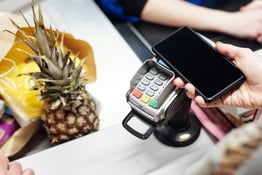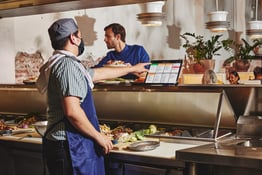The future is upon us, and it comes with goggles.
Tech advances at a dizzying pace, and if you’ve fallen behind, well, that only proves that you’re a normal human being. But 2020 has forced some big, fast changes in the industry. It’s time to get up to speed on how your restaurant can benefit from different tweaks on reality.
>>>RELATED: How to Host Virtual Cooking Classes, Happy Hours & Other Events for Your Restaurant
The more comfortable restaurants become with augmented and virtual reality, the more they can bring to their customer experience—and their bottom line. As this is new, ever-shifting territory, there’s a lot to learn and certainly a set of challenges to work through. But the tech is still quite new, and endlessly adaptable. Once you have a handle on the basics, you’re going to be able to come up with applications for your particular restaurant or space that no one has yet imagined.
Augmented reality vs. virtual reality: What’s the difference?
Augmented, by definition, means adding value to something. Augmented reality (AR) does just that by adding or incorporating digital elements to an existing live view often by using the camera on a smartphone. An example would be creating 3-D images using filters, or interactive menus that show a composite of digital and real-life elements.
Virtual reality (VR) is more heavy-duty. It implies an immersion experience that shuts out the physical world (think those big goggles you see people wear) and creates a wholly new space for interaction.
Entertaining and enticing patrons
Remember the days when you would use the table-top tablet to play trivia while you waited for your nachos and boneless wings? That Applebee’s was ahead of its time! Many fast-casual restaurants still offer interactive devices, but things have come a long way, and can even generate a new revenue stream for restaurants.
Even menus can be like watching a movie. QReal, for instance, has used Snapchat to virtually immerse customers into a restaurant’s menu. Diners scan a QR code, and rotating 3-D images of menu items appear at your fingertips, allowing customers to really scope out the dishes.
Not only does this whet their appetites, but also encourages them to buy more, confidently. Imagine, for instance, that your star entree is a coffee-crusted flank steak. You can demonstrate how the food is prepared, show it off, and not-so-subtly nudge customers toward investing in a fine steak dinner. Showing off 3-D versions of takeout items can also remove the guesswork from those orders—particularly helpful these days, when takeout has never been more popular.
>>>RELATED: How to Start Offering Delivery or Takeout at Your Restaurant
What’s more: Augmented reality menus are straight-up fun! Who wouldn’t want to see their food presented virtually? Millennials and Gen Z customers in particular appreciate a good filter, in case you’re trying to attract a younger clientele.
Hiring and training employees
While less entertaining, augmented reality can make hiring and training employees simpler and safer, as they allow employees to put their skills in action through AR or VR. If owners provide a training manual, for instance, virtual programs like Grasp can “immerse the trainee within a 3D environment with unconstrained movement in all directions.” That lets you put your new hires through paces without exposing them to real flames, germs, blades, and inventory, potentially saving you time and money.
It also saves you having to dedicate a staffer or manager toward lengthy training. Managers are freed up to actually work, rather than being flown to different locations—or simply just not burning shifts—to train staff.
>>>RELATED: How To Staff A Restaurant Right: Positions, Training, Scheduling & More
Making you part of the brand story
Interactivity, the true selling point of VR and AR, also allows restaurants and brands to tell their stories through the technology. For instance, not many people get to visit the Patron tequila distillery in Jalisco, Mexico. But the brand has built a VR experience that transports you there without a passport.
Connecting people with your brand can be powerful. It makes them feel more attached to you and your venture when they get to experience, even virtually, the love and labor that you put into your products. You almost can’t help but order a shot of Patron Añejo once you see how much hands-on work goes into squeezing the agave and barrelling the tequila.
Starbucks uses AR to lead its customers on a deep-dive digital tour of its Shanghai Reserve Rosary, encouraging users to download the application and use a QR code to uncover more information during the tour. The result? Well, for one, you’re probably fiending for some coffee after that screening.
In short, VR and AR take your customers further than just educating them on the brand. Done well, it makes them truly part of the experience—which, in so many facets of food and drink, is the entire point.
[Photo by Eugene Capon from Pexels]





